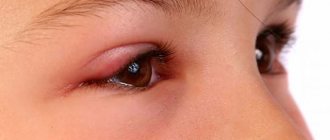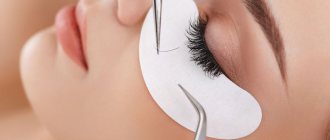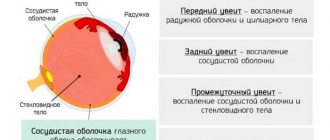The eyeball is the main part of the organ of vision. It consists of the cornea, fluid, anterior chamber, and vitreous. Visually it can be compared to a ball. Thanks to him, a person has the opportunity to visually perceive the world around him.
The negative impact of external factors on it and the ingestion of pathogenic microorganisms cause the development of inflammation. Swelling of the eyeball is an incorrect formulation if you study medical terms, because swelling of the mucous membrane of the conjunctiva adjacent to the eye occurs. This kind of turnover is typical for popular use.
Symptoms
If the eye is swollen and red, but there are no other symptoms, the most likely cause is external factors, dust, wind, rain or sun. Under such conditions, there are no other symptoms other than lacrimation.
Depending on the cause of the disease, the following additional signs may appear:
- Itchy, gritty eyes and soreness are common signs of a condition called conjunctivitis. It is important to distinguish these signs from deep pain that occurs inside the visual analyzer, which indicates a more serious illness. For example, increased intraocular pressure or iritis.
- Nasal congestion, sneezing and watery eyes indicate allergic conjunctivitis. Increased sensitivity to light appears.
- A sore throat, general malaise, nasal congestion and watery eyes are associated with a cold or viral conjunctivitis.
- Vision is temporarily impaired if the cornea is obscured by fluid or pus. With conjunctivitis, visual perception does not change. Loss of acuity is often accompanied by pain in the eye, but there are exceptions such as blockage of blood vessels or hemorrhage.
Other signs include asthenopia, pain, burning, proptosis, and headache.
Photo
Causes of a swollen eye
If the eye is swollen and watery after hypothermia, due to prolonged work at the computer or due to chapping, there is no serious cause for concern.
It is worse if these signs appear due to the development of an inflammatory or infectious pathology. In this case, suspicion falls on the following diseases:
- Contact allergy. Dust, pollen, or pet hair getting into the eyes can cause minor irritation that leads to swelling. If there is no general allergic reaction, swelling and itching will go away on their own.
- Eye irritation. If particles of makeup or dirt get into the eye, it irritates the eye socket. Manifested by redness and swelling.
- Blepharitis is inflammation of the glands at the edge of the eyelid. The condition is usually associated with seborrheic dermatitis or allergies, in the latter case conjunctivitis may be seen. With blepharitis, peeling is pronounced, and the degree of redness depends on the severity of the disease.
- A chalazion is an enlargement of the sebaceous gland. Typically affects only the right or left eye. It looks like a small mound.
- Conjunctivitis is the most common cause of redness and swelling. It affects both visual organs. In both allergic and infectious diseases, the protein is red, hyperemia spreads to the inner surface of the eyelids. If you pull the eyelid down, you may see a red and swollen conjunctiva. In the infectious form, purulent discharge is observed. A common cause is Staphylococcus aureus.
- Iritis is inflammation of the iris. More often the disease is unilateral. Other structures are involved in the process; when the ciliary body is involved, iridocyclitis develops. Symptoms include blurred vision, redness, swelling, and blurred vision.
- Shingles is the same virus that causes chickenpox. In rare cases, a facial rash may appear, causing the eyes to become red and swollen.
- Orbital cellulitis is an infection of the tissue behind the orbital septum. Affects the eyelid, cheeks and eyebrows. The eyes become very swollen, the conjunctiva becomes red. The development of the disease begins with one organ of vision and gradually moves to the second.
- Preseptal/periorbital cellulitis - Like orbital cellulitis, this is an infection, but it occurs around the outside of the eye rather than in the internal tissues. Accompanied by pain and increased body temperature.
- Hypothyroidism is an underactive thyroid gland. Causes fatigue, weight changes, eyes become swollen and congested.
- Graves' disease is the opposite of hypothyroidism. The condition involves an overactive thyroid gland caused by an immune problem. Protruding eyes, double vision, anxiety, weight loss and rapid heartbeat are all symptoms of Graves' disease that can only be diagnosed by a medical professional.
- Systemic disorders (preeclampsia, kidney disease, cardiovascular disease and liver failure) - lead to swelling and fluid retention in the body. Diseases affect the entire body.
- A subconjunctival hemorrhage (caused by a ruptured blood vessel) appears as a red spot and can completely cover the white of the eye.
Treatment
Seek help if symptoms do not go away within 2 days or new signs appear. If redness and swelling do not go away within 1 week using home remedies, consult an ophthalmologist. Some chronic diseases do not cause other symptoms and continue to progress.
Antibacterial eye drops and ointments
The preferred treatment for infectious conjunctivitis is Chloramphenicol. Active against bacteria such as staphylococci, streptococci and Haemophilus influenzae and should improve the condition within 48 hours and completely eliminate a simple infection within 5 days. Chloramphenicol is sold as eye drops or ointment to treat acute bacterial conjunctivitis in adults and children over 2 years of age.
The use of antibacterial drops is effective against viral infections. They will prevent secondary bacterial infection, eliminate redness and swelling. Propamidine is also used for conjunctivitis and blepharitis.
Contact lens wearers should take care to ensure that infection is not caused by the lens itself. Lenses must be removed for the entire period of treatment with antibacterial drops, as they can cause the development of keratitis.
Soft lenses also cause preservatives to build up, resulting in increased irritation. An eye ointment containing dibromopropamidine is prescribed for use at bedtime to treat conjunctivitis.
Scales or pus stuck to the edges of the eyelids are removed with antibacterial eye ointment and by rubbing the edges of the eyelids with diluted, non-irritating baby shampoo.
Other anti-inflammatory drugs
The cause of allergic conjunctivitis, such as pollen or cosmetics, should be identified and, if possible, eliminated. Symptoms are mediated by histamine receptors in the mucous membrane of the eye.
The use of eye drops containing either a single antihistamine (Levocabastine) or a combination (Antazoline) along with a vasoconstrictor (Xylometazoline) is effective in providing rapid symptomatic relief.
If nasal symptoms are present, as in allergic rhinitis, oral antihistamines should be taken in addition to eye drops.
Eye drops containing sodium cromoglycate, a mast cell stabilizer, provide symptomatic relief of allergic conjunctivitis caused by seasonal allergies. Use 4 times daily to maintain their effectiveness.
Other treatments
If blepharitis is associated with seborrheic dermatitis, treatment of the skin disease may be carried out simultaneously with topical treatment of the eyelids.
If you suspect a blockage of the nasolacrimal duct (as with excessive tearing), you can try to relieve the problem by pressing one finger on the tear sac in the inner corner of the eye and gently massaging the duct underneath it.
In general, people should be reminded to take reasonable steps to reduce irritants from environmental factors such as dust, cosmetics, smoke and chlorine in swimming pools.
Causes
As we said earlier, the list of possible causes of swelling of the eyelids is quite wide. These can be serious diseases, or external factors, due to which the eyelids “swell” occasionally.
The search for causes should begin in the ophthalmologist's office
Factors contributing to the formation of eyelid edema
- Hot weather – in summer the problem of edema is more acute, since under the influence of hot weather the process of fluid distribution in the body may not occur correctly. In this case, not only the eyelids swell, but the entire face;
- Diet – an abundance of salty or spicy foods consumed throughout the day. Also, swelling of the eyelids can be caused by excessive water consumption before bed;
- Alcohol abuse;
- Incorrect posture during sleep, in which fluid in the body accumulates in the upper part of the body;
- Long-term lack of sleep, stress;
- If there is a lack of fluid, the body will begin to accumulate it in different areas, including the eyelids. Therefore, it is not recommended to limit your drinking regime.
What diseases cause swelling of the eyelids?
Let's move on to the causes of eyelid swelling related to the health of the eyes and body.
Conjunctivitis
An eye disease that causes damage to the mucous membrane is often accompanied by swelling and redness of the eyelids. In this case, severe itching and purulent discharge from the eyes may occur.
Conjunctivitis can be infectious or non-infectious. Regardless of the nature of the disease, the treatment and necessary medications are determined by an ophthalmologist
.
Blepharitis
Another possible cause of thickening of the eyelid margin is blepharitis. This disease affects the eyelids, can cause ulcers, and can be acute or chronic. Typically, acute blepharitis is caused by bacterial infections and viruses.
Also, swollen eyelids can signal the development of blepharoconjunctivitis. With this disease, the edges of the eyelids and the mucous membrane of the eye are affected.
Both inflammations must be treated under the supervision of an ophthalmologist.
Barley
The most common medical cause of puffy eyelids is an inflammatory condition known as a stye. This disease most often affects the upper eyelid. In this case, a so-called “bump” appears under the affected eyelid, noticeable from the side. In some cases, the seal has a white “head.”
Barley is accompanied by painful sensations in the affected area. The disease is caused by a bacterial infection, so to receive adequate treatment you must consult an ophthalmologist
.
Allergy
An allergic reaction of the body can also manifest itself as swelling of the eyelids. This is observed both with seasonal allergies and with allergies to low-quality cosmetics or other allergens.
In this case, it is also necessary to begin treatment by visiting an ophthalmologist to exclude other possible causes of swelling. If necessary, the doctor will write a referral to a related specialist, in this case, an allergist.
Cold or flu
The eyelids also swell with respiratory diseases. At this time, the work of the lacrimal glands intensifies, and therefore the flow of fluid increases. This is what causes swelling. Most often, both eyes are affected, and swelling can occur simultaneously in the lower and upper eyelids.
Eyelids may swell due to respiratory problems
This condition is usually not dangerous, the swelling subsides by the time of recovery. However, if the patient has recovered and the swelling of the eyelids persists, it is necessary to urgently consult an ophthalmologist.
Diseases of internal organs
Edema can signal serious pathologies of the cardiovascular system or kidneys. In this case, as a rule, there is bilateral swelling of the eyelids. This condition can be dangerous, so it is important to seek help from a specialist as soon as possible!
Start by visiting an ophthalmologist. If the doctor suspects a connection between swelling of the eyelids and the condition of the internal organs, you will be referred to a specialized specialist.
Neoplasms of the eyelids
The occurrence of any type of neoplasm - cysts, benign or malignant tumors - is accompanied by swelling of the eyelids. It is impossible to independently diagnose such pathologies; it is necessary to examine a specialist and select adequate treatment.
Prevention
To prevent your left or right eye from becoming too swollen before going to the doctor, it is recommended to take measures to help avoid worsening the condition. These same measures are a preventive measure against re-swelling and hyperemia. These include:
- maintain a sleep schedule;
- do not drink a lot of liquid after 18.00;
- remove makeup before going to bed;
- take breaks from work.
This condition can be prevented if eye diseases are treated promptly.
Diagnostics
The subconjunctival layer in newborns is not sufficiently developed. Its complete formation ends by the end of the first year of life. The loose layer of connective tissue contains a large number of lymphatic formations. The tarsal conjunctiva has folds, when cut, glandular formations can be detected.
Stratified columnar epithelium also contains goblet cells, which can grow against the background of various pathological conditions.
If microcirculation is disrupted in the conjunctival area, the pathological process leads to some significant transformations. Swelling, hyperemia, and hemorrhages occur, indicating a local and systemic disease.
Typically, swelling occurs in the area of the transitional fold and conjunctiva. Chemosis of the latter is sometimes so pronounced that it first covers the cornea and then begins to protrude from the palpebral fissure.










